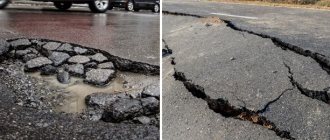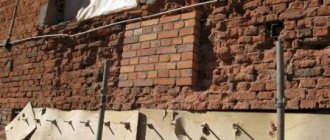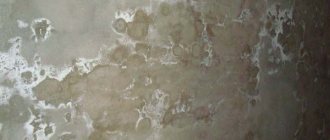Beton-House.com
Website about concrete: construction, characteristics, design. We combine the experience of professionals and private craftsmen in one place
Exposure of reinforcement is a serious structural problem
By and large, the repair of reinforced concrete can be called strengthening, since if the integrity of the shell of the product, and even more so the reinforcement in it, is damaged, the strength characteristics are reduced. The need for this may arise in two cases: when the purpose of the structure changes, which implies an increase in loads; and when the structure has collapsed and cannot safely perform its functions. The third option may arise when both of these reasons are combined.
What methods exist to eliminate such problems, what causes them, and how to repair concrete in winter? We will try to give a comprehensive answer to these and other questions by presenting a video in this article for clarity.
- Large shells
- Thixotropic compounds
Types of defects and causes of their occurrence
Most often, reinforced concrete structures erected several decades ago need repair. In those days, poor quality concrete was much more common than today.
The technology for producing artificial stone was very weak: the water-cement ratio was not strictly observed, the control of the granulometric composition and quality of the aggregates was weak, the required thickness of the protective layer was not maintained, which is why now the reinforcement is simply exposed.
To make an accurate “diagnosis”, such structures require a thorough examination, during which drawings, detailed descriptions and high-quality photographs are made. And when you also have initial data with drawings, it is much easier to draw the right conclusions and choose a method for restoring the structure.
Search for reinforcement in the foundation
When the structure is open for visual inspection, you can see with the naked eye how different the damage is from different sides.Note: When selecting materials for repairing concrete of hidden structures, it is very important to know exactly how much reinforcement they contain, where it is located and in what condition it is. If the thickness of the protective layer does not exceed 9 cm, an electromagnetic device will help determine the position of the reinforcement in concrete.
- The north is more exposed to low temperatures, which means the number of freezing and thawing cycles increases. From the south, sudden temperature changes are more common, which can lead to deeper cracks.
- New reinforced concrete structures may also require repairs. Most often, such a need arises after they have been stripped, when the defects resulting from poor-quality concreting appear in all their glory.
- The reason for this may be unsatisfactory quality materials and poor compaction of concrete. Sometimes a not entirely successful design solution does not allow certain areas to be fully concreted.
- Very often, the appearance of defects is caused by outdated formwork – a reusable inventory option. When a vibrator operates, cracks appear in worn-out formwork through which cement laitance flows out, which is why the surface of the structure is not smooth, but gravelly.
Methods for dealing with concreting defects
All defects are divided into two groups:
- In the first, there are superficial imperfections such as the same gravelly surface or shallow shells, sagging and unevenness. Repairing the concrete surface is not difficult - it does not require developing special measures or incurring significant costs.
Shallow sinks in concrete
- The second group includes such defects as voids, deep or even through holes and cracks. And also, a big problem is the deviation of the resulting structure from the design parameters.
A through crack is a very serious defect.
And here are the ways to eliminate them.
Removing imperfections from the surface
Elimination of defects in the form of a gravelly surface or a surface dotted with small shells is carried out as follows:
- If the surface is gravelly, it is cleaned with a steel brush, washed with water, and then plastered with a solution with volumetric proportions of 1 part Portland cement (M400-500) to 2 parts sand.
- When it is necessary to remove sinks, they are removed with a chisel from loose concrete around the edges, after which a metal brush, washing and caulking with a solution are also used.
Note: For significant volumes of work, repairs to concrete walls or foundations can be carried out using shotcrete. We will tell you more about this method later.
- Sludges of concrete must be removed immediately after removing the formwork, before the concrete has yet reached full strength. The tool used is a chisel, pick or jackhammer.
Deep defects
Large cavities, one of the most common defects, are usually the result of concrete being dropped into the formwork from a great height. They also arise from poor-quality compaction, the use of an overly hard mixture, or from its delamination and setting during long-term transportation.
The height of concrete discharge into the formwork affects the quality of the structure
Large shells
The most vulnerable places are those areas where a lot of reinforcement is concentrated, or it is simply inconvenient to fill the formwork with concrete and compact it. In such cases, the concrete repair technology is selected taking into account the number and size of defects.
- In vertical load-bearing structures - for example: columns that operate under high loads, the shells are cleared down to the reinforcement, and after washing with water they are concreted.
- For this purpose, fine-grained concrete using Portland cement M400-500, produced directly on site, is usually used.
- It is important that the brand of the repair compound is an order of magnitude higher than the structural one - this is the only way to ensure good adhesion.
Note! If the sink is through, then clearing it can greatly weaken the load-bearing capacity of the column. Therefore, it is first reinforced with metal plates, and only then, through tubes installed at the site of the defect, cement mortar is pumped into the voids - or a reinforced concrete cage is installed around the perimeter of the structure.
Through voids
Quite often in construction practice we encounter such a defect as voids, which are usually formed when the concrete mixture does not pass through the formwork in a given area.
- The size of the voids can be quite impressive - such that even the reinforcement is exposed. At the same time, due to the rupture of concrete, the solidity of the structure is disrupted. How are such defects eliminated?
- As in other cases, the defective area is first cleaned and washed. Then, where it is necessary to concrete, they install a suspended formwork that covers the upper joint and fill it with the mixture. Concrete is made using fine-grained crushed stone, adding a hardening accelerator to it.
- Together with a representative of the construction laboratory, the builders check the quality of the mixture, and only after that they begin concreting. In places where defects are repaired, especially in winter, the concrete is heated with steam, infrared lamps or electric heating.
Warming up a concrete column using a thermomat
Large cracks
Another serious defect in concrete is cracks that occur as a result of soil settlement; stresses associated with changing temperatures; other types of deformities. Solving such a problem is quite difficult, and for this purpose they usually invite a representative from the organization that designed the building.
- A commission is created that must examine structures, identify the cause of cracks, measure the extent of their opening and establish through observation the fact of its progression.
Note: The simplest way to control the behavior of cracks is to install gypsum beacons on them.
- Stable cracks are sealed after jointing and cleaning by injecting a solution into them under pressure or by spraying (dry shotcrete).
- If it is determined that the cracks continue to expand, designers are obliged to urgently develop a project to strengthen the defective structure.
After the construction organization has completed the work, all of it is documented with the appropriate act.
What is shotcrete
Throughout the story, we mentioned that imperfections in the concrete surface can be eliminated using shotcrete. It's time to explain in a little more detail what it is.
- Shotcrete is actually plaster, a layer of mortar applied to a surface by spraying under high pressure.
- At the same time, it fills all the smallest cracks and pores, which contributes to the highest adhesion to the base surface.
- The applied layer can be quite thick, so there must be wire or reinforcing mesh underneath it. What exactly depends on the scale of the work being performed.
- Before installing the reinforcement, cracks on the surface are treated with a sandblaster or a strong stream of water to remove loose concrete and dirt.
- Shotcrete can be made with either Portland or alumina cement and can be applied either dry or wet.
- In the first case, the dry mixture is loaded into the installation (gun), and supplied by compressed air through a nozzle, in which humidification occurs. It is this method that allows you to apply thick layers of concrete when repairing structures in just one pass.
- With the wet method, the shotcrete composition is pre-mixed with water, mixed and supplied to the application site with a pump. With wet application there is less dust and less solution loss due to rebound. This method ensures a more uniform application of the mixture, which is very convenient when during repairs you need to get a thin layer of gunite.
Both methods can be used to restore damaged reinforced concrete. And also with their help you can strengthen the walls of the pit, repair the foundation, restore old stone/brickwork, etc.
Innovative technology for preparing concrete mixtures
All over the world it is believed that high-quality concrete mixtures should contain a total of 500...600 kg (per cubic meter) of fine components in the form of cement and inert microfiller. However, in Russia, finely dispersed components in a concrete mixture amount to 300... 400 kg and are represented only by cement. This causes the appearance of defects both on the surface and inside monolithic reinforced concrete structures. A generally accepted solution to the problem of improving the quality of monolithic reinforced concrete structures is the use of self-compacting concrete mixtures. However, due to the complexity of preparation and the high cost of such mixtures, they are used only in 2-5% of cases. An alternative to SCC can be a two-stage technology for the preparation of concrete mixtures developed by the author [6]. The first stage of this technology involves mixing cement, a mineral additive and a plasticizer, the second involves mixing a complex binder obtained at the first stage, as well as water, sand and crushed stone using traditional technology using existing BSU equipment. As practice has shown, in concrete mixtures prepared using the proposed technology there is practically no water separation and separation, although they have a very plastic consistency (cone spread is more than 500 mm), and the quality of monolithic reinforced concrete structures is very high. In the proposed technology, at the first stage, both a mixer for the production of dry mixtures and a ball mill can be used. In the case of using a ball mill, the grade of cement increases and, accordingly, it becomes possible to reduce its consumption. Two-stage technology is especially advantageous in the production of modern concrete mixtures containing a large number of components (cement, microfiller, plasticizer, hardening retarder or accelerator, antifreeze additive, stabilizer for underwater concreting, etc.).
Modern materials for concrete repair
Above we described how concrete defects are eliminated in large-scale construction. Similar problems may arise for private developers, who have to deal with them on their own.
Many new generation materials developed specifically for repair and waterproofing work will help with this.
Thixotropic compounds
Thixotropic are dry mixtures that contain high-quality cement, reinforcing fiber, mineral and plasticizing additives. When mixed with water, they produce high-strength, non-shrinking mortars that are very effective in repairing concrete surfaces - both horizontal and vertical.
What are thixotropic materials?
Such compositions are used in both large-scale and individual construction.
And here are the types of repairs that can be performed with their help:
- Restoring the volume of a destroyed concrete structure, including if this was due to corrosion of reinforcement;
- Elimination of those defects mentioned above that can occur during monolithic concreting;
- Repair of concrete pavements, filling joints between slabs;
- Elimination of potholes on enclosing structures and foundations;
Repair of concrete surfaces using TsMID materials
- Leveling and waterproofing walls and floors in basements;
- Repair of concrete steps;
- Sealing leaks, including pressure ones, in wells and tanks.
And this is not a complete list of areas where such materials can be used. Their price is quite high, but it is well worth it.
Proposals for improving control methods
Work to identify defects in our organization has been established and is being carried out as planned. However, in our opinion, it is necessary to continue to improve both methods and control tools. After analyzing the existing and used methods for identifying and measuring defects, I would like to propose the following:
1. Continue to clarify the list of defects that are subject to detection during the inspection of products and structures and link them in more detail to the classifier of the hazard of defects. In particular, it would be possible to introduce an additional gradation of defects based on maintainability, namely, introduce such categories of defects as removable or irreparable.
2. When instrumentally determining the opening width of cracks, replace the Brinell microscope, which is inconvenient in construction conditions, with a set of needle-type probes, ensuring measurement accuracy with its help at the level of 0.02 mm (like a microscope).
3. Legalize the determination of the depth of cracks, since this makes it possible to classify detected cracks as shrinkage cracks (shallow - up to 5% of the thickness of the structure) or force cracks - with a depth of more than 5% of the thickness of the structure.
4. If there are sinkholes, assess the surface quality of reinforced concrete products and structures only according to categories (A1...A7). Also worthy of consideration is the method for assessing surface quality, which is based on differential porosity indicators (average pore size and coefficient of variation of their sizes) with its reference to GOST 13015 [5].
5. When laying concrete mixtures in monolithic reinforced concrete structures, it is imperative to control the spreading of the cone and water separation of the concrete mixtures
Suggestions for reducing defects
The problem of improving the quality and reducing the defectiveness of monolithic reinforced concrete structures can be solved in different ways. According to the author, in terms of accessibility and cost, these methods can be arranged in the following order:
- Applying lubricant to the formwork only by mechanized means.
- Use of aggregates with a maximum particle size of no more than 10 mm.
- The use of cements containing more than 20% mineral additives. The most effective in this regard may be the use of Portland slag cement (contains up to 80% ground blast furnace slag).
- Restoring the consistency of concrete mixtures before laying them in structures is carried out exclusively with the help of additional introduction of a plasticizer.
- Order a concrete mixture 1 grade higher than required. In this case, by increasing the cement content, part of it will act as a microfiller and will reduce water separation and delamination of concrete mixtures, which in turn will reduce the defectiveness of hardened concrete (cavities, under-compacted areas, etc.)
- When preparing concrete mixtures, it is mandatory to introduce a finely ground component (mineral additive). Information - in many countries, the introduction of finely ground components into concrete mixtures is fixed at the legislative level.
How and with what to repair a concrete surface
Concrete is a composite material that, when hardened, forms an artificial stone with a capillary-porous structure. It is prone to destruction from exposure to mechanical and other loads.
To repair concrete outdoors or indoors, special mixtures are used. They are sold ready-made or made independently by mixing the proportions of the required components.
Injection
Also, when deciding how to seal holes in a concrete wall in the most effective way, especially if not only a crack has appeared, but also water is flowing through it, you should pay attention to this method.
Injection technology involves introducing a special composition (polyurethane or epoxy resin, microcement or waterproofing mixture) into the thickness of concrete using special injection pumps that create strong pressure.
To perform such restoration of defects it is necessary:
So, we looked at how to fix a hole in a concrete wall yourself, but what if we are talking about aerated concrete?
Content
- Types of defects Uneven, gravelly surface
- Emptiness inside a monolithic wall
- Cracks
- Voids, cavities on the surface
- Availability of shells
- Contact check
Concrete problems can be seen on a well-cleaned surface without dust or traces of contamination. Correction of detected defects is mandatory, with the agreement of the customer of the construction project and the developer.
The quality of concrete is regulated by GOST R53778-210. Defects in concrete mixture are divided into two categories:
- Significant defects that worsen the performance properties of concrete structures several times, reducing their service life.
- Critical defects that make the building dangerous and unsuitable for use. Identification of such defects completely blocks the construction process until they are completely eliminated.
The use of low-quality concrete leads to serious defects that threaten the integrity of the building.
Filling potholes, cracks and sinkholes
When repairing plaster, solutions similar to the existing plaster are used. Currently, it is easier not to make plaster mortar from various components, but to buy it ready-made in the form of dry mixtures such as Vetonit, Teplon, Ceresit, Rotband, Starateli and others, into which you just need to add water and mix thoroughly. If the plaster is being repaired for wallpapering or paneling, then any plaster mixture that complies with the rules of material compatibility can be used. After drying, the repaired areas will differ in color from the old plaster, but this is allowed for wall cladding or thick wallpaper.
Cracks and potholes are cleared of weak, crumbling edges. Thin cracks are widened and deepened to approximately 10 mm, wide cracks are deepened to the full thickness of the plaster (Fig. 1). The crack is moistened with water or a primer so that the repair plaster solution will better adhere to the old plaster.
Detect and repair cracks
Moisten cracks with primer or water and fill with repair mixture
Rub the crack with a float, lapping the boundaries
Fig. 1. Minor repairs to plaster: filling potholes, cracks and sinks
If priming is done with water, then if there is insufficient wetting, setting between the old and new plaster will not occur and new cracks may appear. The area to be repaired is filled with mortar and leveled with a spatula so that it is in the same plane as the old plaster. Next, the spot to be repaired is rubbed off. They do not grout immediately, but after some time, when the solution still retains its plasticity, but no longer reaches for the grater. Lightly pressing the tool against the surface to be repaired, make circular movements with the trowel, partially grabbing the old plaster. In other words, making circular movements with a grater, they “mix the boundaries” - rubbing old plaster, soaked with water by priming, with a new repair composition into each other. During this process, the grater is moistened by periodically dipping it into a bucket of water. It should be borne in mind that early rubbed plaster cracks, and late rubbed plaster crumbles. If the grinding is poor, even a well-leveled and rubbed solution will stand out from the general plane.
If the cracks being repaired were primed not with water, but with a primer, then the latter, as a rule, is given time to dry. It depends on the type of primer used, some of them involve working “wet on wet”, others “wet on dry”. Read the instructions on the primer canister. If the manufacturer writes that the primer needs to dry, then so be it. Repair using a primer may not involve mixing the old plaster with the repair one, but rather involve gluing the new plaster composition to the old one. When working with cement binder solutions, on old cement and cement-lime plasters, it is better to prime with water or primers without waiting for them to dry (even if the instructions say about drying the primer), i.e. according to the “wet on wet” principle. If gypsum repair compounds are used on cement plasters, then it is better to give the primer time to dry. The same should be done when working with cement repair mortars on old gypsum plasters. In this case, the dried primer acts as a separating and gluing layer between dissimilar materials.
However, we repeat once again that it is better to use repair compounds using the same binder as the old plaster. Then you don’t have to worry about buying special primers - prime with ordinary water, work “wet on wet” and rub over, mixing the boundaries.
Plasters made on the basis of a cement binder are shrinkage mortars. Multiple small cracks showing on the wall after the mortar has set and dried. To remove these cracks from the plane of the plastered wall, grinding is performed. If the plaster requires grinding, it is cleaned of plaque, residues of wallpaper glue or paint and moistened well with water. Grinding is done in areas of up to 1 m². A thin layer of mortar is applied to the wall with a brush. Or the solution is applied to the wall with a trowel, placing small portions on it and spreading it over the wall in separate strokes, at a distance of 100–150 mm from each other (Fig. 2).
Rice. 2. Circular and random grinding of plaster
They work “wet on wet”! If a section of the wall has dried out, it is wetted again. For grinding, a solution of creamy consistency of lime dough is used one to one (1:1) mixed with sand sifted through a sieve with millimeter holes. Lime-gypsum mortar, pure cement paste, pure lime paste, as well as pure sand are not used for grouting. All of them have a bad effect on the strength and crack resistance of the plaster.
Using a trowel in a circular motion, rub the repair solution applied to the wall into the old wetted plaster. The grater is pressed with its working side against the plaster and made circular movements clockwise and counterclockwise. The tubercles of the old mortar are cut off, and the holes and cracks are filled with mortar. At the same time, the float compacts the solution. If the holes in the old plaster are deep, then use a trowel to remove the mortar that has accumulated on the edges of the trowel, transfer it to the work surface and cover the depressions with it. If the mortar has accumulated on the edges of the grater, but there are no holes, then it is removed with a trowel and sent back to the mortar box. If there are holes and there is little mortar on the edges of the trowel, take the mortar from the mortar box with a trowel and apply it to the working surface of the trowel. In those places where protrusions are visible on the plaster, press on the grater, and where there are depressions, release the pressure. Do I need to repeat that such work will not work on a poorly wetted wall? During work, the trowel is periodically washed so as not to rub dried mortar into the plaster and moistened so that it glides better and transfers moisture to the wall. Place a bucket of water near you.
Circular movements of the float usually leave circular streaks on the plaster. To avoid them, the plaster is rubbed down in a hurry. It is done using fresh grout in a circular manner. First, approximately 1 m² of surface is grouted in a circular manner and immediately grouted in steps. There should be no bumps or missing places on the rubbed surface, since subsequent finishing, and especially painting, will show all the shortcomings of the plaster.
Source
Working seams for concreting
Techinformer No. 11 is devoted to the topic of repairing concreting joints; I will only note that for repairing concreting joints it is more advisable to use “KTtron-2”, and for filling shrinkage joints repair materials “KTtron-3” or “KTtron-3 T500” should be used, depending on the brand strength of concrete.
Technological holes from coupling bolts
Technological holes for coupling bolts. If it is possible to approach the holes from both sides, it is necessary to groove the mouths of the holes to a depth of 40 mm on each side. For sealing, repair material KTtron-3 (or KTtron-3 T500) and suture material KTtron-2 are used. Only the inside of the hole is filled with the repair compound, and the areas lying closer to the surface are filled with joint compound.











